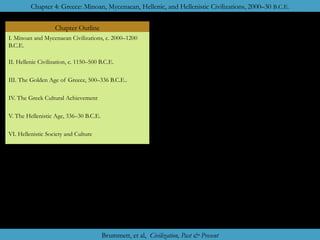More Related Content
Similar to 0321333209 04 (20)
0321333209 04
- 1. Chapter 4: Greece: Minoan, Mycenaean, Hellenic, and Hellenistic Civilizations, 2000–30 B.C.E.
Chapter Outline
I. Minoan and Mycenaean Civilizations, c. 2000–1200
B.C.E.
II. Hellenic Civilization, c. 1150–500 B.C.E.
III. The Golden Age of Greece, 500–336 B.C.E..
IV. The Greek Cultural Achievement
V. The Hellenistic Age, 336–30 B.C.E.
VI. Hellenistic Society and Culture
©2006, Pearson Education, Inc.
Brummett, et al, Civilization, Past & Present
- 2. Chapter 4: Greece: Minoan, Mycenaean, Hellenic, and Hellenistic Civilizations, 2000–30 B.C.E.
I. Minoan and Mycenaean Civilizations,
c. 2000–1200 B.C.E.
A. The Minoans
King Minos — legendary
Language — undeciphered
hieroglyphics
Linear A — syllabic
Sir Arthur Evans
archaeologist
Knossos
“Palace of Minos”
Art
murals
realistic, everyday scenes
©2006, Pearson Education, Inc.
Brummett, et al, Civilization, Past & Present, Part One; Classical Origins
- 3. Chapter 4: Greece: Minoan, Mycenaean, Hellenic, and Hellenistic Civilizations, 2000–30 B.C.E.
I. Minoan and Minoan and Mycenaean Civilizations
B. The Myceneans
Achaeans — Indo-Europeans
from north, c. 2000
Mycenae
Heinrich Schliemann (1822–1890)
acropolis — massive palace
royal tombs, after 1500
expansion
Knossos, c. 1450
Linear B
deciphered by Michael Ventris
C. Troy
Heinrich Schliemann
Iliad
1870 — excavation begins
Troy VI or VII (1200–1125 B.C.E.)
©2006, Pearson Education, Inc.
D. Fall of Mycenaean Civilization
Brummett, et al, Civilization, Past & Present, Part One; Classical Origins
- 4. Chapter 4: Greece: Minoan, Mycenaean, Hellenic, and Hellenistic Civilizations, 2000–30 B.C.E.
II. Hellenic Civilization, c. 1150–500 B.C.E.
Dark Ages (1150–750 B.C.E)
Geography
A. Homeric Age
information scarce
Iliad, Odyssey
arête
excellence, virtue
aristoi = the best
aristocracy
©2006, Pearson Education, Inc.
Brummett, et al, Civilization, Past & Present, Part One; Classical Origins
- 5. Chapter 4: Greece: Minoan, Mycenaean, Hellenic, and Hellenistic Civilizations, 2000–30 B.C.E.
II. Hellenic Civilization, c. 1150–500 B.C.E
B. From Oligarchy to Tyranny
polis (plural poleis) = city-state
acropolis = high city
agora = marketplace
Oligarchy = government of the few
c. 750 — nobles in control
Colonization (750–550 B.C.E.)
Magna Graecia = Great Greece
Southern Italy
Economic transformation
production for trade
land hunger
> Tyrants, c. 650 B.C.E.
hoplite phalanx
tyrannus = absolute ruler
©2006, Pearson Education, Inc.
Brummett, et al, Civilization, Past & Present, Part One; Classical Origins
- 6. Chapter 4: Greece: Minoan, Mycenaean, Hellenic, and Hellenistic Civilizations, 2000–30 B.C.E.
II. Hellenic Civilization, c. 1150–500 B.C.E.
C. Athens to 500 B.C.E.
7th Century — oligarchy
council of nobles dominant
9 archons = rulers
Solon — 594 B.C.E.
economic and social reform:
Council of Four Hundred
Popular Assembly
Pisistratus — 560 B.C.E.
tyrant
public works
weakening of nobles
Cleisthenes
508–502 B.C.E. — reforms
further weakened nobility
ostracism
D. Sparta to 500 B.C.E.
monarchy > oligarchy
ephors = overseers
Messenians — neighbors
©2006, Pearson Education, Inc.
conquest > helots
Lycurgus
legendary?
Brummett, et al, Civilization, Past & Present, Part One; Classical Origins
- 7. Chapter 4: Greece: Minoan, Mycenaean, Hellenic, and Hellenistic Civilizations, 2000–30 B.C.E.
III. The Golden Age of Greece, 500–336
B.C.E.
A. Persian Wars
King Cyrus
conquest of Lydia, 547 B.C.E.
> revolt of Ionian poleis
crushed by Darius I
490 B.C.E. — to Greece
Marathon — Greek victory
480 B.C.E. — Xerxes
Thermopylae
Themistocles
Salamis Bay
479 B.C.E. — Plataea
Impact
Athenian confidence
Pericles (461–429 B.C.E.)
©2006, Pearson Education, Inc.
Brummett, et al, Civilization, Past & Present, Part One; Classical Origins
- 8. Chapter 4: Greece: Minoan, Mycenaean, Hellenic, and Hellenistic Civilizations, 2000–30 B.C.E.
III. The Golden Age of Greece, 500–336 B.C.E.
B. Athenian Society
Women
Slavery
C. Athenian Imperialism
Sparta isolationist
Delian League — 478 B.C.E.
navy of 200 ships
468 B.C.E. — Goal achieved
D. Peloponnesian War (431–404 B.C.E.)
Spartan League v. Athenian Empire
416 B.C.E. — Melians enslaved
415 B.C.E. — expedition to Syracuse
E. Macedonia
King Philip II (359–336 B.C.E.)
Demosthenes
speaks against Philip
Chaeronea — 338 B.C.E.
Macedonian victory
©2006, Pearson Education, Inc.
Brummett, et al, Civilization, Past & Present, Part One; Classical Origins
- 9. Chapter 4: Greece: Minoan, Mycenaean, Hellenic, and Hellenistic Civilizations, 2000–30 B.C.E.
IV. The Greek Cultural Achievement IV. The Greek Cultural Achievement
A. Values
sophrosyne D. The Great Philosophers
hubris Socrates (470–399 B.C.E.)
nemesis 399 — condemned
Plato (427–347 B.C.E.)
B. Greek Religion Republic
Zeus The Academy (388 B.C.E. 529 C.E.)
Hesiod (c. 700 B.C.E.) Aristotle (384–322 B.C.E.)
Mysteries —Orphic, Eleusinian Lyceum
mystae = initiates
afterlife — Elysium
C. Early Greek Philosophy
Physikoi — physical world
Thales of Miletus c. 600 B.C.E.
natural causes
human reason
Search for first principle
Pythagoras of Samos (c. 582–500 B.C.E.)
Anaximander
©2006, Pearson Education, Inc.
Xenophanes
Sophists — late 5th B.C.E.
Brummett, et al, Civilization, Past & Present, Part One; Classical Origins
- 10. Chapter 4: Greece: Minoan, Mycenaean, Hellenic, and Hellenistic Civilizations, 2000–30 B.C.E.
IV. The Greek Cultural
Achievement
E. Fields of Inquiry
Medicine
Hippocrates
420 B.C.E. — founds
school
History
Herodotos of Halicarnassus
(c. 484–c. 425 B.C.E.)
Thucydides (460–400 B.C.E.)
History of Peloponnesian War
©2006, Pearson Education, Inc.
Brummett, et al, Civilization, Past & Present, Part One; Classical Origins
- 11. Chapter 4: Greece: Minoan, Mycenaean, Hellenic, and Hellenistic Civilizations, 2000–30 B.C.E.
©2006, Pearson Education, Inc.
Brummett, et al, Civilization, Past & Present, Part One; Classical Origins
- 12. Chapter 4: Greece: Minoan, Mycenaean, Hellenic, and Hellenistic Civilizations, 2000–30 B.C.E.
©2006, Pearson Education, Inc.
Brummett, et al, Civilization, Past & Present, Part One; Classical Origins
- 13. Chapter 4: Greece: Minoan, Mycenaean, Hellenic, and Hellenistic Civilizations, 2000–30 B.C.E.
©2006, Pearson Education, Inc.
Brummett, et al, Civilization, Past & Present, Part One; Classical Origins
